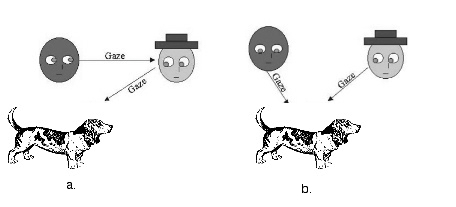The awareness that self and a partner are both attending to the same object or event. Descriptively, it is the sharing of attention to a common object by two people interacting with each other, such as a mother and her child (see figure below). On this basis, infants begin to engage in sustained bouts of joint attention by the age of about 12 months. Joint attention assumes an aspect of play when attending to an object by adult and child is ‘mutually manifest‘ (i.e., what is being attended to is manifest to both partners). The importance of joint attention for cognitive and language has featured strongly in the works of Jerome Bruner, as witnessed by the following statement that joint attention “… sets the deictic limits that govern joint reference, determines the need for referential taxonomy, establishes signaling intent, and eventually provides a context the development of explicit predication.” (Bruner, 1977, p. 287, in Studies in mother-infant interaction, edited by H.Rudolph Schaffer). ‘Deictic’ here is taken to mean something along the lines of specifying spatial and temporal location from the perspective of one or more participants in an act of speech (e.g., showing or pointing directly at something while using words such as this, that, and those). The notion of joint attention also figures strongly in research on children with autism, it constituting one of the first signs that child may be autistic. Joint attention, therefore, assumes an important feature in the theory of mind.
